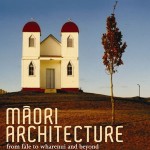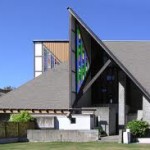Maori Architecture
I confess to being a late starter in learning about our indigenous architecture. Growing up in suburban Hamilton was an impediment.
Two years ago I had my first real functioning marae experience. It was an occasion of great sadness – a tangi for a fine young man, at Tu Teao Marae in Te Teko. But through the sadness, I couldn’t help but note the wonder of how the special sequencing, the disposition of the buildings around the central open space, and the inter linking of each activity around that space, actually worked.
The architecture functioned in support of the welcoming process, the protocols, the sense of belonging, the continuity of tradition, and the seemingly effortless feeding of thousands of guests over the three days.
Cultures world-wide try to celebrate their indigenous visual arts, dance and music and we are surrounded by examples of Maori influences in those art forms. But for architecture – the handmaiden of the arts – the influences have been less obvious. Instead modern New Zealand architecture has developed around what is often an unsatisfactory pot-pouree of irrelevant overseas architectural influences. Two recent media have sought to bring a greater balance to our understanding of what is really relevant.
I’ve become a bit of a fan of Maori Television – in part due to Miss M having more authority over the remote control than I. But the emergence of Whare Maori earlier this year sealed my respect for the channel. A local 13-part series on architecture playing on prime time television! You can still watch it on-line if you missed it.
It more than deserved its recent win for best information programme at the 2011 Aotearoa Film and Television Awards.
Its presenter Rau Hoskins, is a sort of local Kevin McLeod, passionately but intelligently telling the history of this country’s very own indigenous architecture.
 Together with Deidre Brown’s excellent 2009 book Maori Architecture, it identified its evolving incorporation of new technologies, new materials and new sensibilities.
Together with Deidre Brown’s excellent 2009 book Maori Architecture, it identified its evolving incorporation of new technologies, new materials and new sensibilities.
The contributions of architects Rewi Thompson, Anthony Hoete and of course John Scott are well documented by both Deidre and Rau.
I was particularly moved that Whare Maori devoted an entire episode (Epsisode 9) to John Scott and his work.
Whenever I think of John I think of him often arriving to visit me from Hawke’s Bay in the middle of the night night as he preferred to navigate his road trips by the stars. He was a relaxed naturally gifted architect, who enjoyed a beer, and who was widely respected.
Such was his influence in Hawke’s Bay that when I was asked to design a house in Havelock North many years ago, John’s approval of the design was a condition of the site being subdivided. I still have the copy of our plans and elevations written with his notes .
His seminal works were brilliantly and perfectly, bi-cultural.
 His Futuna Chapel at Karori is the youngest Grade 1 NZ Historic Places Trust-listed building. Although his Aniwaniwa Visitor Centre at Waikaremoana, from which Colin McCahon’s Tuhoe triptych has now been removed, is facing an uncertain future.
His Futuna Chapel at Karori is the youngest Grade 1 NZ Historic Places Trust-listed building. Although his Aniwaniwa Visitor Centre at Waikaremoana, from which Colin McCahon’s Tuhoe triptych has now been removed, is facing an uncertain future.
In his appearance on Whare Maori Rewi Thompson also repudiated the widespread perception that Maori architecture was either a meeting house or a pa palisade.
Rewi and I travelled together on a lecture tour in the US in 1986. The tour, which included Ian Athfield from Wellington and John Blair from Queenstown drew its biggest audiences at Harlem and lower class districts of Chicago and Los Angeles, than poncy Harvard or Yale.
Rewi worried about Maori architecture being perceived as static images, but his work manages to distill the organic essence of the culture in new ways, without it losing its meaning. The ‘indigenous architecture’ theme struck a chord with students from Hispanic and African countries who are themselves on the search for their own cultural identity.
Rewi – if you’re reading this and wonder how the white lad from Hamilton got on at the tangi then you might be interested to know that my cred was raised a notch or two when I happilly gulped down a plate of the local delicacy kainga pirau, or rotten corn.
I was born with almost no sense of smell, which enabled me to accomplish this feat, but I am confident that my eyes and my sensibilities will always devour new Maori Architecture.
